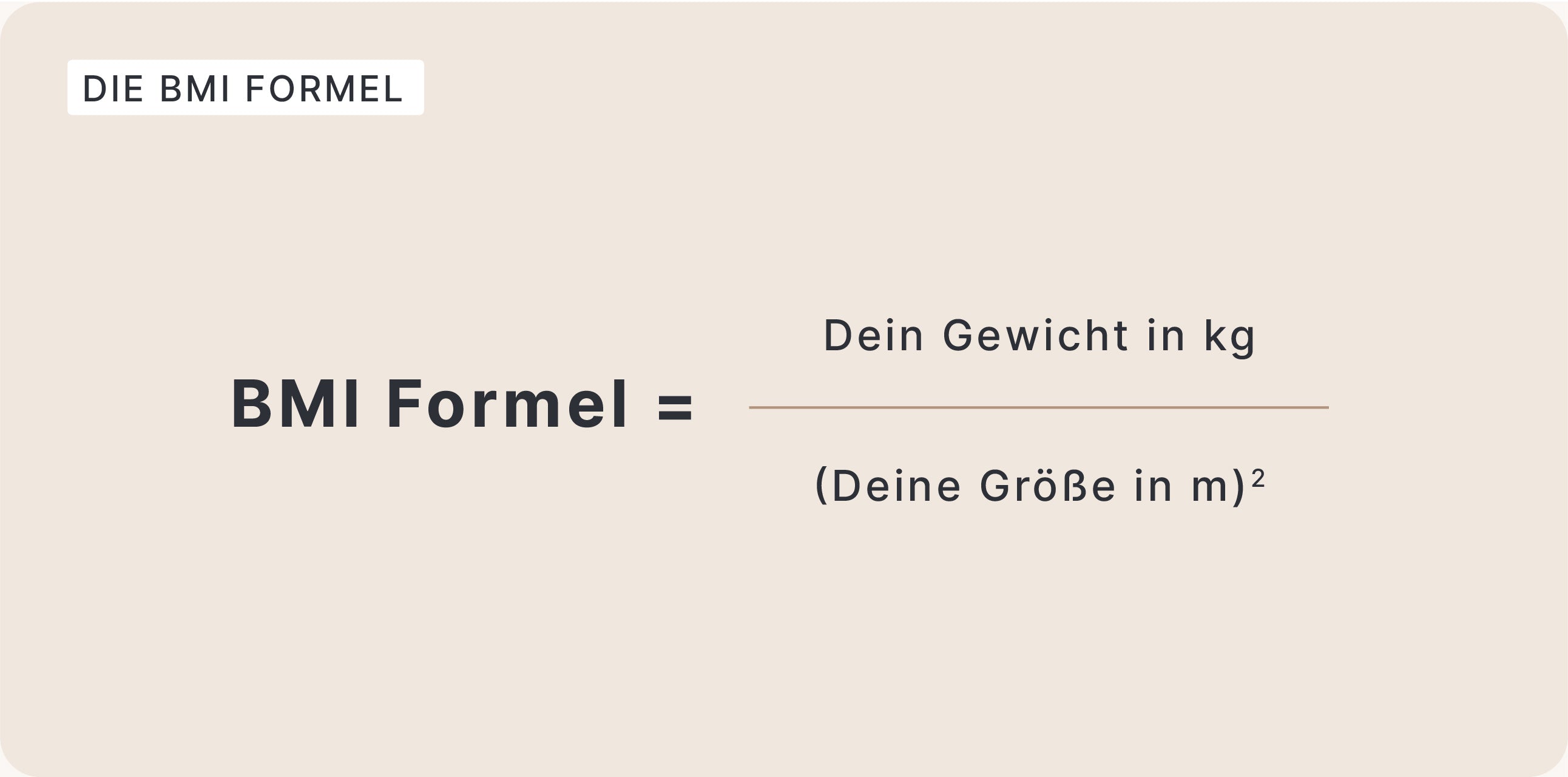BMI calculator
Accordingly, our BMI calculator requires you to enter your age and gender in addition to your height and weight. It is therefore possible that the values you receive from us may differ from those of the other BMI calculators. This is simply because our calculator takes more data into account.

Success stories with SHEKO
SHEKO has already helped many people achieve their feel-good weight! Are you ready for your own success story?
Do you want to lose weight?
Want to know how many calories you need? Click here for our calorie calculator.
This is the BMI
BMI has something to do with height and body weight? Correct. The body mass index is defined more precisely by relating body weight to height².
The BMI can only provide rudimentary information about whether you really have an ideal weight. It is generally regarded as a guide value and cannot be used as an indicator of healthy body measurements. For this, body fat and muscle mass would also have to be taken into account.
There have been many attempts to define ideal body measurements and derive ideals of beauty and health from them. However, in the past it was rather easy to simply define height in centimetres minus one hundred as the normal weight. A man of about 185 cm height should ideally weigh 85 kg, a woman of 175 cm 75 kg. The disadvantage of this very rough calculation is obvious: men and women have different proportions of bone, fat and muscle mass and cannot be lumped together for this reason alone. Do you remember? Physics, density, volume ... Yes, well, something more appropriate had to be found.
This is what the BMI is used for
The body mass index is generally used as a kind of estimate for the body fat percentage. The BMI was invented by a mathematician in Belgium in 1832, but the actual term BMI has existed since the 1970s. The index value only really became known when life insurance companies in the USA came up with the idea of using the index to calculate insurance premiums. Since the early 1980s, the index has also been used by the World Health Organization. The use of the value as a criterion for civil service appointments has been heavily criticized.
Today, we are (finally) accepting much more diversity again, especially when it comes to body shapes. We have declared war on hashtags such as #bodyshaming and with #nofilter we want to show/see more real, "imperfect" people who simply don't photoshop away their belly fat. Nevertheless, we must not ignore health. The BMI should therefore not actually be categorized in terms of appearance, but in terms of health (Ha - tell that to your subconscious!). The fact is, regardless of current scientific findings, being overweight is not healthy:
- Being overweight or obese, regardless of the degree, can cause cardiovascular disease or diabetes.
- Joints suffer from a high body weight and wear out more quickly, for example.
- There is a risk of high blood pressure, metabolic disorders and strokes
- If the fat is literally "in the way", this can cause breathing disorders or restricted movement.
The exact definition of overweight does indeed change regularly and the BMI is actually somewhat outdated, but it is still not entirely unsuitable as an initial measure.
What the BMI says
You can easily determine your body mass index with a BMI calculator. But what can you really do with this figure?
According to the classification of the World Health Organization (WHO), the value can be divided into different categories, which we have summarized in the following table.
| You are way too thin | BMI under 16 |
| You are way too thin | BMI 16 or 17 |
| You still don't weigh enough | BMI between 17 and 18,5 |
| Everything is great | BMI between 18,5 and 25 |
| It could be better | BMI 25 to 30 |
| You are too overweight | BMI between 30 and 35 |
| You urgently need to lose weight | BMI 35 and above |
You can calculate the BMI, but this does not give you an ideal statement about your ideal weight. Many parameters are not taken into account. However, you can always use the BMI as a reference point for weight control.
How the BMI is assessed
General guideline values set by the DGE (German Nutrition Society) apply. These are different for men and women. Women have an ideal weight with a BMI between 19 and 24. For men, a BMI between 20 and 25 is in the green zone.
For once, equality has no place here, which is why a slightly different standard generally applies to men:
| BMI women | BMI men | |
| BMI underweight | <19 | <20 |
| BMI normal weight | 19 - 24 | 20 - 25 |
| BMI overweight | 25 - 30 | 26 - 30 |
| BMI obesity level I | >30 | >30 |
| BMI obesity level II | >35 | >35 |
| BMI obesity level III | >40 | >40 |
A BMI over 30 indicates an increased body fat percentage. If the value is below 20, the person concerned is underweight.
How the BMI is calculated
You finally want to calculate your BMI yourself. No problem. As already mentioned, your body weight is divided by your height squared. Mathematically (you have to go through this for a moment), it looks like this:

Still have questions? Then here is an example:
Let's assume you are 1.65 meters tall and weigh 72 kilograms. So, 72 : (1.65)² = 26.47. Or for a woman who is 1.75 m tall and weighs 65 kg, the result would be 21.24. Great - what does that tell us now? As described, there is a classification here. Common sense and the BMI calculation say that the woman should look relatively normal.
It's even easier with our online BMI calculator, which you can find at the top of the page.
What to look out for in the BMI
You have already noticed that the BMI norm has its limits and cannot be generalized to all people. And anyway - "norm"! Why is the index allowed to simply claim something like that? Let's just say: it can, but only because we don't take it too seriously. The BMI should really only be a guideline and serve as a rough estimate of your weight. And you certainly shouldn't get bogged down in decimal places!
The BMI does not take into account the ratio of muscle mass to fat mass, bone density or factors such as age or gender. Sporty women with a few extra muscles could therefore suddenly slip into the "overweight" category. Obelix, who always insists on only having heavy bones, could also be a little bit right ... Bones do have different diameters from person to person and can therefore sometimes be a little heavier. The BMI is already in the red zone. Doctors even consider the abdominal circumference to be more meaningful than the BMI. For women, the abdominal circumference should be less than 88 centimetres, for men less than 102 centimetres.
Body weight and height alone are not enough. In order to calculate the ideal weight, factors such as age and gender must also be taken into account.

Children and teenagers
The body fat percentage in children and adolescents changes as they grow up, which means that the assessment of BMI is different from that of adults. In order to calculate the BMI, the percentile curves are used, which are specially developed for this age group.
Athletes and bodybuilders
According to the BMI calculator, people who exercise regularly can be overweight. However, this is not due to body fat, but to muscle mass, which is also reflected in the kilograms on the scales.
BMI with age
The metabolism changes from around the age of 40. We then automatically build up small fat reserves so that the BMI normal value shifts slightly upwards. On the other hand, we lose muscle mass as we get older, which means weight loss, because muscles are heavier than fat. The BMI normal value then shifts slightly downwards.
And now? Recommendations for action:
Is your BMI over 25 or even over 30? Then you are probably overweight and should do something about it. Losing weight and eating healthily is the order of the day. But indulgence doesn't have to mean going without. A SHEKO Shake fills you up, replaces a complete meal and provides important vitamins and minerals.
If your BMI is too high, you should reconsider your diet. Potatoes and cereal products provide lots of nutrients. Fruit and vegetables are a must, preferably five times a day. Losing weight doesn't mean getting frustrated, because there are also delicious recipes for those with a sweet tooth: You can conjure up great menus with our SHEKO recipes. How about our protein muffins or protein waffles, for example?
5 facts about the body mass index
Summary & conclusion
The BMI (Body Mass Index) is a ratio of body weight to height. This allows body weight to be statistically assessed and classified into different categories.
The value can be quickly determined using a BMI calculator. This can serve as a guideline, but does not give you a clear indication of whether you are really overweight. For this, your gender, age and body fat percentage would also need to be taken into account. For athletes, the information is often ambiguous. Muscle mass adds a lot of weight, which is wrongly assessed as overweight. It is also somewhat outdated in terms of the latest medical findings and could therefore also give a false picture.
Effective weight control works better with a reliable calorie calculation anyway. It's best to check your daily calorie intake with our calorie calculator and only check your BMI from time to time. As long as you take the calculated value with a grain of salt and follow our tips, it is a good guideline for keeping track!
Despite the disadvantages or weaknesses mentioned, the BMI is still one of the most frequently used methods for assessing body weight and health.
FAQ on the topic of BMI
The BMI is one way of estimating your weight. Now you will get some brief and precise answers to questions about the BMI.
How do you calculate the BMI?
What is a normal BMI?
What BMI at what age?
What is the BMI for women?
Sources:
-
Technicians' Health Insurance
https://www.tk.de/service/app/2002866/bmirechner/bmirechner.app -
Wikipedia
https://de.wikipedia.org/wiki/Body-Mass-Index -
Pharmacy Review
https://www.apotheken-umschau.de/gesund-bleiben/abnehmen/body-mass-index-den-bmi-berechnen-706435.html







